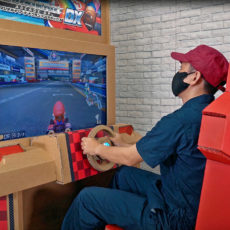
Nintendo’s Switch 2, set to launch next week, arrives with a curious feature that’s already sparking chatter among gamers: a pre-installed film layer on its screen that Nintendo insists you leave untouched. This isn’t the peelable plastic you’d expect to strip away during an unboxing frenzy. Nor is it a traditional screen protector you’d pick up at GameStop for $10.
Nintendo’s official health and safety manual for the Switch 2, recently shared by Nintendo of Europe, includes a clear directive: “The screen is covered with a film layer designed to prevent fragments scattering in the event of damage. Do not peel it off.” This warning, tucked into the “Careful Usage” section is a deliberate design choice rooted in safety and practicality. Unlike the glossy, removable plastic sheets that shield new devices during shipping, this film is a permanent fixture, bonded to the Switch 2’s LCD panel to serve a specific purpose: keeping broken glass from turning into a hazardous mess.
- 【Ultra-Fast Installation, Auto-Alignment in 30 seconds!】 Installing a screen protector might seem like a headache, but our OneTouch Nintendo...
- 【Indestructible Ultra 9H Glass for Ultimate Protection】Our Nintendo Switch 2 tempered glass screen protector leads the market with Ultra-high 9H...
- 【Ultra-Clear and Ultra-Sensitive】Our nintendo switch 2 screen protector uses high-quality materials and advanced coating technology to provide a...
Screen protectors, as most of us know them, are aftermarket accessories—typically thin sheets of plastic or tempered glass you apply to guard against scratches, smudges, or minor dings. They’re replaceable, often peeling off with a satisfying tug when they get too scuffed. Nintendo’s film layer, however, plays a different game. It’s an anti-scattering film, a safety feature integrated during manufacturing to ensure that if the screen cracks—say, from a drop onto a hardwood floor—the glass doesn’t shatter into sharp fragments that could cut hands or scatter across your living room.
This approach isn’t new for Nintendo. The Switch OLED model, released in 2021, also featured an anti-scattering adhesive film with identical wording in its manual: “The screen is covered with a film layer designed to prevent fragments scattering in the event of damage. Do not peel it off.” The continuity suggests Nintendo has doubled down on this safety measure, especially as the Switch 2’s larger 8-inch LCD screen could pose a greater risk of fragmentation if damaged. Unlike traditional screen protectors, which prioritize scratch resistance or glare reduction, this film is engineered to hold the glass together, much like the laminated windshield of a car.
Why not just slap a “screen protector” label on it and call it a day? It’s not that simple—function and purpose set it apart. Classic screen protectors are DIY add-ons, optional shields built to soak up daily dings and scratches, acting as disposable armor you swap out when they’re battle-scarred. Nintendo’s anti-scattering film, by contrast, is a permanent part of the screen’s architecture. Removing it could compromise the display’s integrity, potentially allowing glass shards to break free in a worst-case scenario. As one Reddit user noted, “In my experience, these plastic layers are pretty obvious they are intended to remain. They don’t come off quickly.”
[Source]


![amFilm Auto-Alignment OneTouch for Nintendo Switch 2 Screen Protector [7.9''] 2025 Tempered Glass,...](https://m.media-amazon.com/images/I/41-JRL9kyWL._SL160_.jpg)







